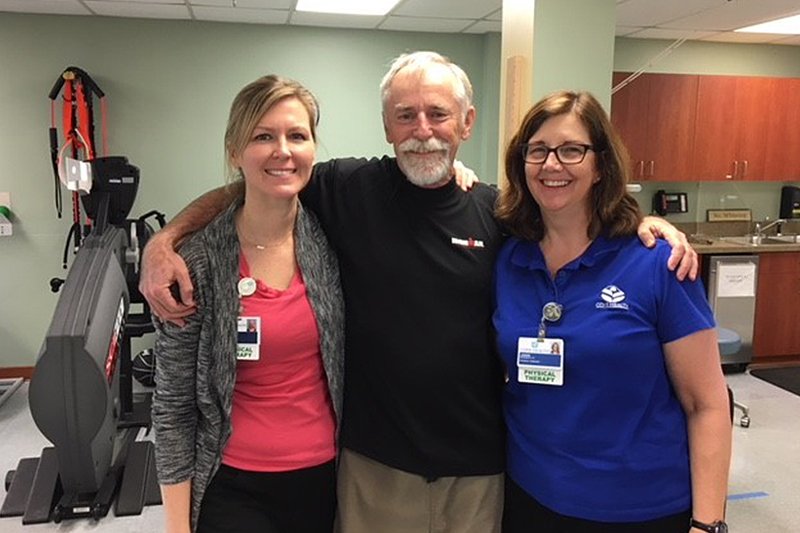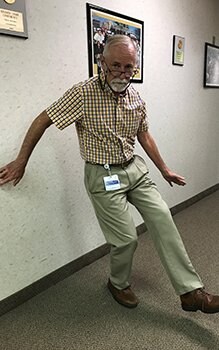When A Doctor Becomes a Patient
 Follow total knee replacement, sports medicine physician Bert Fields, MD leaned on Cone Health physical and occupational therapists to help with recovery.
Follow total knee replacement, sports medicine physician Bert Fields, MD leaned on Cone Health physical and occupational therapists to help with recovery.
As a sports medicine physician with Cone Health, Bert Fields, MD, often recommends exercise to help solve muscle and joint problems. He recently prescribed an hour and a half of exercise twice a day for two months for a special patient—himself.
Dr. Fields has always been active, playing tennis and running long distances. But a time came when he couldn’t straighten his knees all the way, and running was so painful he had to give it up. The solution was to have total knee replacement surgery. Not many can do it this way, but he chose to have BOTH knees replaced at the same time—a tough undertaking for sure.
 He prepared for this double major surgery by doing “prehab.” He consulted with some Cone Health physical therapists and did exercises before surgery to get himself strong and ready for the challenges ahead. Right after surgery, still groggy from anesthesia and in the recovery room, he started his own rehab by tightening the muscle at the front of the thigh and raising his leg up off the bed.
He prepared for this double major surgery by doing “prehab.” He consulted with some Cone Health physical therapists and did exercises before surgery to get himself strong and ready for the challenges ahead. Right after surgery, still groggy from anesthesia and in the recovery room, he started his own rehab by tightening the muscle at the front of the thigh and raising his leg up off the bed.
Dr. Fields was helped at every stage of his recovery by Cone Health physical and occupational therapists. His first PT session was not long after surgery at Wesley Long Hospital. This involved walking from the bed to the hall, which looked like a short distance to him. He soon appreciated that his therapist knew a longer distance would be too much for his first steps on new knees. He describes that short walk as the most painful thing he’s ever experienced.
From Wesley Long Hospital he went to Cone Comprehensive Inpatient Rehab. In his early days there he learned from occupational therapists how he was going to get out of bed, take a shower and tie his shoes. He was impressed with how OT and PT worked as a team, informing each other about his progress so they could tailor their next sessions to meet his needs. He says the therapists were sensitive to both what he could and couldn’t do, yet didn’t get in the way of his exceeding their expectations.
When Dr. Fields left Inpatient Rehab, his recovery moved to Cone Health Outpatient Rehabilitation. There therapists progressed him according to both his wants and needs, working on flexibility, strength and aerobic conditioning. His program included using the Pilates Reformer, which helped improve the muscle control in his legs and enabled him to pedal a stationary bike for endurance.
He wants potential recipients of joint replacement to know that rehab for this is not going to be pain free. He found that taking prescribed pain medications prior to his therapy sessions helped him to tolerate therapy better, which gave him quicker results, and that in turn enabled him to stop the pain meds sooner than if he hadn’t done it that way.
Dr. Fields has a lot more to say about his rehab experience, not to mention all the work he did on his own to promote a full and quick recovery. But his outcome is what speaks volumes: six months after having both his knee joints replaced, while in England to do some teaching about sports medicine, he hiked 260 miles, climbing 3,000 feet along the way. He got back to playing tennis sooner than he thought too, and now plays about 10 hours a week.
Hard work pays off.